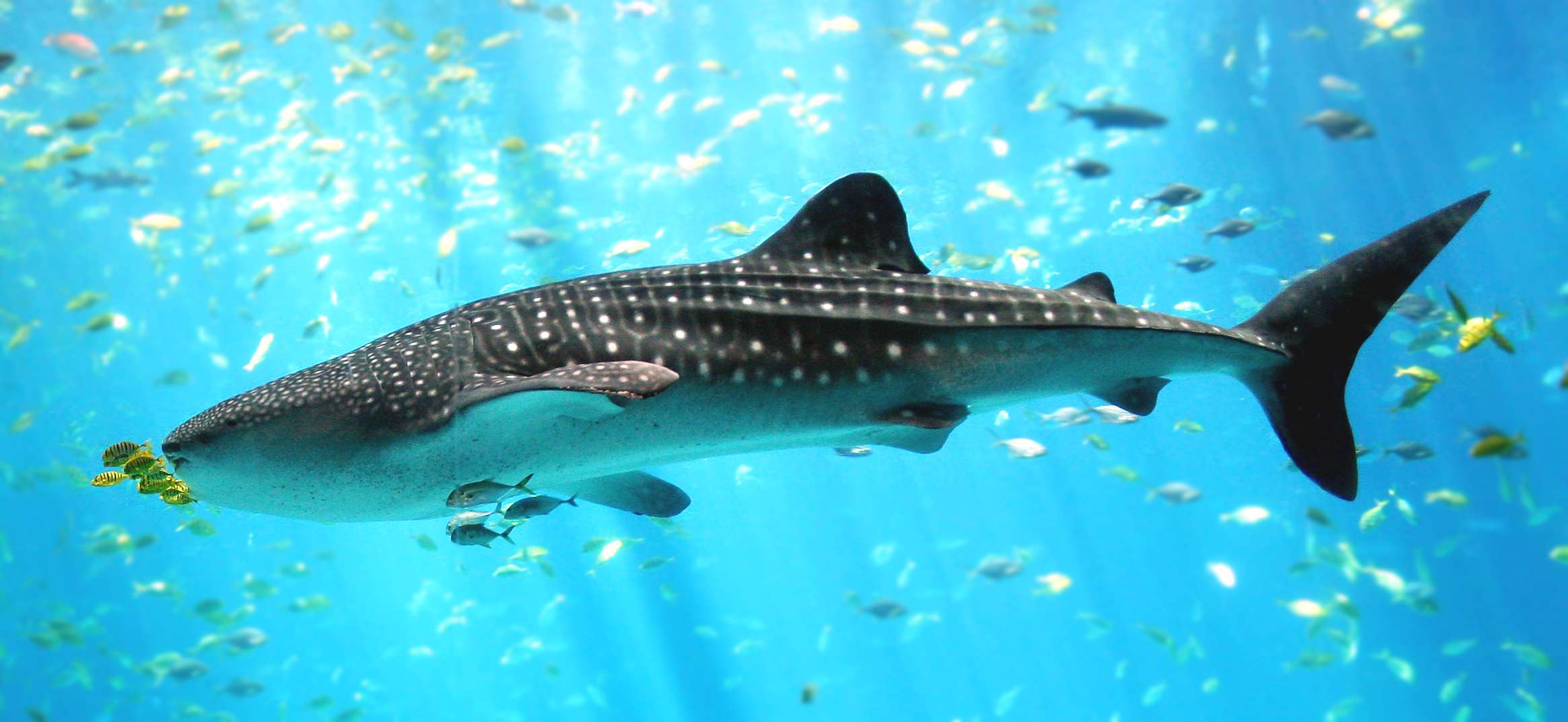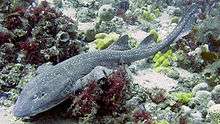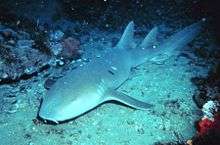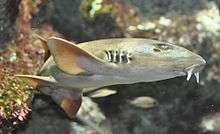Carpet shark
Carpet sharks are sharks classified in the order Orectolobiformes. Sometimes the common name "carpet shark" (named so because many species resemble ornately patterned carpets) is used interchangeably with "wobbegong", which is the common name of sharks in the family Orectolobidae. Carpet sharks have five gill slits, two spineless dorsal fins, and a small mouth that does not extend past the eyes. Many species have barbels.
| Carpet sharks | |
|---|---|
 | |
| Whale shark (Rhincodon typus) at the Georgia Aquarium | |
| Scientific classification | |
| Kingdom: | Animalia |
| Phylum: | Chordata |
| Class: | Chondrichthyes |
| Subclass: | Elasmobranchii |
| Infraclass: | Euselachii |
| Superorder: | Selachimorpha |
| Order: | Orectolobiformes Applegate, 1972 |
| Families | |
|
See text | |
Characteristics
The carpet sharks are a diverse group of sharks with differing sizes, appearances, diets, and habits. They first appeared in the fossil record in the Early Jurassic; the oldest known orectolobiform genera are Folipistrix (known from Toarcian to Aalenian of Belgium and Germany), Palaeobrachaelurus (Aalenian to Barremian) and Annea (Toarcian to Bajocian of Europe).[1] All species have two dorsal fins and a relatively short, transverse mouth that does not extend behind the eyes. Besides the nostrils are barbels, tactile sensory organs, and grooves known as nasoral grooves connect the nostrils to the mouth. Five short gill slits are just in front of the origin of the pectoral fin and the fifth slit tends to overlap the fourth one.[2] A spiracle occurs beneath each eye which is used in respiration. The only exception to this rule is the whale shark, the spiracles of which are situated just behind the eyes.[3] Carpet sharks derive their common name from the fact that many species have a mottled appearance with intricate patterns reminiscent of carpet designs. The patterning provides camouflage when the fish is lying on the seabed.[4] The largest carpet shark is the whale shark (Rhincodon typus) which can grow to a length of 14 m (46 ft). It is the largest species of fish, but despite its size, is not dangerous, as it is a filter feeder, drawing in water through its wide mouth and sifting out the plankton. The smallest carpet shark, at up to about 30 cm (12 in) long, is the barbelthroat carpet shark, (Cirrhoscyllium expolitum).[3] Some of the most spectacularly coloured members of the order are the necklace carpet shark (Parascyllium variolatum), the zebra shark (Stegostoma fasciatum), and the ornate wobbegong (Orectolobus ornatus). Nurse sharks and whale sharks have a fringe of barbels on their snouts, and barbelthroat carpet sharks (Cirrhoscyllium expolitum) have barbels dangling from their throat regions.[4]
Behaviour
Most carpet sharks feed on the seabed in shallow to medium-depth waters, detecting and picking up molluscs and crustaceans and other small creatures.[3] The wobbegongs tend to be ambush predators, lying hidden on the seabed until prey approaches. One has been observed swallowing a bamboo shark whole.[5]
The methods of reproduction of carpet sharks varies. Some species are oviparous and lay eggs which may be liberated directly into the water or may be enclosed in horny egg cases. Some female sharks have been observed to push egg cases into crevices and this would be an added protection for the developing embryos. Other species are ovoviviparous and the fertilised eggs are retained in the mother's oviduct. There, the developing embryos, which are usually few in number, feed on their yolk sacs at first and later hatch out and feed on nutrients secreted by the walls of the oviduct. The young are born in an advanced state, ready to live independent lives.[3]
Distribution
Carpet sharks are found in all the oceans of the world but predominantly in tropical and temperate waters. They are most common in the western Indo-Pacific region and are usually found in relatively deep water.[3]
Classification
The order is small, with seven families in 13 genera and with a total of around 43 species:
| Family | Image | Common name | Genera | Species | Description |
|---|---|---|---|---|---|
| Brachaeluridae |  |
Blind sharks | 1 | 2 | Blind sharks are found in shallow coastal waters up to 110 m (360 ft) deep off the eastern coast of Australia.[6] They are distinguished by the presence of long barbels, large spiracles, and grooves around the nostrils. They have two dorsal fins, placed close together on the back, and a relatively short tail. Blind sharks feed on small fish, cuttlefish, sea anemones, and crustaceans. The female retains the eggs in her body until they hatch (ovoviviparity), during which time the embryos feed solely on the egg yolk.[6] Despite their name, blind sharks are not blind; their name comes from their habit of closing their eyes when taken out of water.[6] There are only two species. |
| Ginglymostomatidae |  |
Nurse sharks | 3 | 4 | Nurse sharks have long tails and distinctive mouths which are far ahead of the eyes and before the snout (subterminal), an indication of the bottom-dwelling (benthic) nature of these sharks. Also present on the lower jaw are two fleshy barbels, chemosensory organs which help the nurse sharks find prey hidden in the sediments. Common in shallow, tropical, and subtropical waters, these sharks are sluggish and docile bottom-dwellers. Nurse sharks typically attack humans only if directly threatened. The largest species can reach a length of 4.3 m (14 ft).[7] |
| Hemiscylliidae |  |
Bamboo sharks | 2 extant 4 extinct | 16 extant 6 extinct | Bamboo sharks, sometimes called longtail carpet sharks, are distinguished by a relatively long snout with subterminal nostrils.[8] They are relatively small sharks, with the largest species reaching only 121 cm (48 in) in length. They have elongated, cylindrical bodies, with short barbels and large spiracles. As their common name suggests, they have unusually long tails, exceeding the length of the rest of their bodies. They are found in shallow waters of the tropical Indo-Pacific. They are sluggish fish, feeding on bottom-dwelling invertebrates and smaller fish.[9] |
| Orectolobidae |  |
Wobbegong sharks | 3 extant 1 extinct | 12 extant 1 extinct | Wobbegong sharks are well camouflaged with symmetric, bold patterns resembling a carpet. The camouflage is improved by the presence of small weed-like whisker lobes surrounding the jaw, which help to camouflage it and act as sensory barbs.[10] Wobbegongs are bottom-dwelling and spend much time resting on the sea floor. They are found in shallow temperate and tropical waters of the western Pacific Ocean and eastern Indian Ocean, chiefly around Australia and Indonesia. Most species have a maximum length of 1.25 m (4.1 ft) or less, and the largest reach about 3 m (9.8 ft) in length. Wobbegongs are generally not dangerous to humans unless provoked.[11] |
| Parascylliidae |  |
Collared carpet sharks | 2 | 8 | Collared carpet sharks have elongated, slender bodies, cat-like eyes, and barbels behind their chins. They are found only in the shallow waters of the western Pacific. They are relatively small sharks, with the largest species reaching no more than 91 cm (2.99 ft) in adult length.[12] |
| Rhincodontidae |  |
Whale sharks | 1 | 1 | The whale shark is the largest extant fish species, growing over 12 m (40 ft) long and weighing over 20 tonnes (45,000 lb). It is a slow-moving filter feeder with a very large mouth, feeding mainly, though not exclusively, on plankton. The whale shark is a pelagic species, living in the open sea in tropical and warm oceans with a lifespan around 70 years.[13] The IUCN has assessed it as vulnerable.[14] |
| Stegostomatidae | Zebra sharks | 1 | 1 | Zebra sharks are distinctive in appearance, with five longitudinal ridges on a cylindrical body, a low caudal fin comprising nearly half the total length, and a pattern of dark spots on a pale background. They grow to a length of 2.5 m (8.2 ft), and are found throughout the tropical Indo-Pacific, frequenting coral reefs and sandy flats to a depth of 62 m (210 ft). They are nocturnal and spend most of the day resting motionless on the sea floor. They are innocuous to humans. The IUCN has assessed them as vulnerable and some evidence indicates their numbers are dwindling.[15] |
Order Orectolobiformes
- Family Brachaeluridae Applegate (blind sharks)
- Genus Brachaelurus Ogilby, 1908
- Brachaelurus colcloughi (Ogilby, 1908) (bluegrey carpetshark)
- Brachaelurus waddi (Bloch & J. G. Schneider, 1801) (Blind shark)
- Genus Brachaelurus Ogilby, 1908
- Family Ginglymostomatidae Gill, 1862 (nurse sharks)
- Genus Ginglymostoma J. P. Müller & Henle, 1837
- Ginglymostoma cirratum Bonnaterre, 1788 (nurse shark)
- Ginglymostoma unami Del-Moral-Flores, Ramírez-Antonio, Angulo & Pérez-Ponce de León, 2015 [16]
- Genus Nebrius Rüppell, 1837
- Nebrius ferrugineus (Lesson, 1831) (tawny nurse shark)
- Genus Pseudoginglymostoma Dingerkus, 1986
- Pseudoginglymostoma brevicaudatum (Günther, 1867) (short-tail nurse shark)
- Genus Ginglymostoma J. P. Müller & Henle, 1837
- Family Hemiscylliidae Gill, 1862 (bamboo sharks)
- Genus Chiloscyllium J. P. Müller & Henle, 1837
- Chiloscyllium arabicum Gubanov, 1980 (Arabian carpetshark)
- Chiloscyllium burmensis Dingerkus & DeFino, 1983 (Burmese bamboo shark)
- Chiloscyllium griseum J. P. Müller & Henle, 1838 (grey bamboo shark)
- Chiloscyllium hasselti Bleeker, 1852 (Hasselt's bamboo shark)
- Chiloscyllium indicum (J. F. Gmelin, 1789) (slender bamboo shark)
- Chiloscyllium plagiosum (Anonymous, referred to Bennett, 1830) (white-spotted bamboo shark)
- Chiloscyllium punctatum J. P. Müller & Henle, 1838 (brownbanded bamboo shark)
- Genus Hemiscyllium J. P. Müller & Henle, 1837
- Hemiscyllium freycineti (Quoy & Gaimard, 1824) (Indonesian speckled carpetshark)
- Hemiscyllium galei G. R. Allen & Erdmann, 2008[17] (Cenderwasih epaulette shark)
- Hemiscyllium hallstromi Whitley, 1967 (Papuan epaulette shark)
- Hemiscyllium halmahera G. R. Allen, Erdmann & Dudgeon, 2013[18] (Halmahera epaulette shark)
- Hemiscyllium henryi G. R. Allen & Erdmann, 2008[17] (Henry's epaulette shark)
- Hemiscyllium michaeli G. R. Allen & Dudgeon, 2010[19] (Milne Bay epaulette shark)
- Hemiscyllium ocellatum (Bonnaterre, 1788) (epaulette shark)
- Hemiscyllium strahani Whitley, 1967 (hooded carpetshark)
- Hemiscyllium trispeculare J. Richardson, 1843 (speckled carpetshark)
- Genus Chiloscyllium J. P. Müller & Henle, 1837
- Family Orectolobidae Gill, 1896 (wobbegong sharks)
- Genus Eucrossorhinus Regan, 1908
- Eucrossorhinus dasypogon (Bleeker, 1867) (tasselled wobbegong)
- Genus Orectolobus Bonaparte, 1834
- Orectolobus floridus Last & Chidlow, 2008 (floral banded wobbegong)
- Orectolobus halei Whitley, 1940.[20]
- Orectolobus hutchinsi Last, Chidlow & Compagno, 2006.[21] (western wobbegong)
- Orectolobus japonicus Regan, 1906 (Japanese wobbegong)
- Orectolobus leptolineatus Last, Pogonoski & W. T. White, 2010 (Indonesian wobbegong)
- Orectolobus maculatus (Bonnaterre, 1788) (spotted wobbegong)
- Orectolobus ornatus (De Vis, 1883) (ornate wobbegong)
- Orectolobus parvimaculatus Last & Chidlow, 2008 (dwarf spotted wobbegong)
- Orectolobus reticulatus Last, Pogonoski & W. T. White, 2008 (network wobbegong)
- Orectolobus wardi Whitley, 1939 (northern wobbegong)
- Genus Sutorectus Whitley, 1939
- Sutorectus tentaculatus (W. K. H. Peters, 1864) (cobbler wobbegong)
- Genus Eucrossorhinus Regan, 1908
- Family Parascylliidae Gill, 1862 (collared carpet sharks)
- Genus Cirrhoscyllium H. M. Smith & Radcliffe, 1913
- Cirrhoscyllium expolitum H. M. Smith & Radcliffe, 1913 (barbelthroat carpetshark)
- Cirrhoscyllium formosanum Teng, 1959 (Taiwan saddled carpetshark)
- Cirrhoscyllium japonicum Kamohara, 1943 (saddle carpetshark)
- Genus Parascyllium Gill, 1862
- Parascyllium collare E. P. Ramsay & Ogilby, 1888 (collared carpetshark)
- Parascyllium elongatum Last & Stevens, 2008 (elongate carpetshark)
- Parascyllium ferrugineum McCulloch, 1911 (rusty carpetshark)
- Parascyllium sparsimaculatum T. Goto & Last, 2002 (ginger carpetshark)
- Parascyllium variolatum (A. H. A. Duméril, 1853) (necklace carpetshark)
- Genus Cirrhoscyllium H. M. Smith & Radcliffe, 1913
- Family Rhincodontidae (J. P. Müller & Henle, 1839) (whale sharks)
- Family Stegostomatidae Gill, 1862 (zebra sharks)
- Genus Stegostoma J. P. Müller & Henle, 1837
- Stegostoma fasciatum (Hermann, 1783) (zebra shark)
- Genus Stegostoma J. P. Müller & Henle, 1837
See also
References
- Alex Srdic; Christopher J. Duffin; David M. Martill (2016). "First occurrence of the orectolobiform shark Akaimia in the Oxford Clay Formation (Jurassic, Callovian) of England". Proceedings of the Geologists' Association. 127 (4): 506–513. doi:10.1016/j.pgeola.2016.07.002.
- Nelson, J. S. (1994). "Order Summary for Orectolobiformes". Fishbase. Retrieved 2013-10-12.
- Du Plessis; Amelia. "Orectolobiformes". Sharks. Retrieved 2013-10-11.
- "Carpet shark". Encyclopædia Britannica online. Retrieved 2013-10-13.
- Scales, Helen (2012-02-13). "Pictures: Shark Swallows Another Shark Whole". National Geographic: Daily News. Archived from the original on 2013-10-13. Retrieved 2013-10-13.
- Froese, Rainer, and Daniel Pauly, eds. (2009). "Brachaeluridae" in FishBase. January 2009 version.
- Froese, Rainer, and Daniel Pauly, eds. (2011). "Ginglymostomatidae" in FishBase. February 2011 version.
- Compagno, Leonard J.V. (1984). Sharks of the World: An Annotated and Illustrated Catalogue of Shark Species Known to Date. Rome: Food and Agriculture Organization. ISBN 92-5-101384-5.
- Froese, Rainer, and Daniel Pauly, eds. (2009). "Hemiscylliidae" in FishBase. January 2009 version.
- "Wobbegongs - five species encountered in Queensland". Queensland Primary Industries and Fisheries. 2009-03-02. Archived from the original on 2009-06-14. Retrieved 2009-06-14.
- Kuiter, Rudie (1999). Guide to Sea Fishes of Australia (amended ed.). New Holland Publishers (Aust.) Pty Ltd. p. 12. ISBN 1-86436-091-7.
- Froese, Rainer, and Daniel Pauly, eds. (2011). "Parascylliidae" in FishBase. February 2011 version.
- Froese, Ranier; Pauly, Daniel (eds.). "Rhincodon typus". FishBase. Retrieved 17 September 2006.
- Norman, B. (2005). "Rhincodon typus". IUCN Red List of Threatened Species. 2005. Retrieved 18 August 2011.CS1 maint: ref=harv (link)
- Pillans, R.; Simpfendorfer, C (2003-04-30). "Stegostoma fasciatum". IUCN Red List of Threatened Species. 2003-04-30. Retrieved 2013-10-15.
- Moral-Flores, L.F.D.; Ramírez-Antonio, E.; Angulo, A. & Pérez-Ponce de León, G. (2015). "Ginglymostoma unami sp. nov. (Chondrichthyes: Orectolobiformes: Ginglymostomatidae): a new species of nurse shark from the Tropical Eastern Pacific". Revista Mexicana de Biodiversidad. 86: 48–58. doi:10.7550/rmb.46192.
- Allen & Erdmann (2008). "Two new species of bamboo sharks (Orectolobiformes: Hemiscylliidae) from Western New Guinea". Aqua (Miradolo Terme). 13 (3–4): 93–108.
- Allen, G.R., Erdmann, M.V. & Dudgeon, C.L. (2013): Hemiscyllium halmahera, a new species of Bamboo Shark (Hemiscylliidae) from Indonesia. aqua, International Journal of Ichthyology, 19 (3): 123-136.
- Allen & Dudgeon (2010). "Hemiscyllium michaeli, a new species of Bamboo Shark (Hemiscyllidae) from Papua New Guinea". Aqua International Journal of Ichthyology. 16 (1): 19–30.
- Huveneers (2006). "Redescription of two species of wobbegongs (Chondrichthyes: Orectolobidae) with elevation of Orectolobus halei Whitley 1940 to species level" (PDF). Zootaxa. 1284: 29–51.
- Last, Chidlow & Compagno (2006). "A new wobbegong shark, Orectolobus hutchinsi n. sp. (Orectolobiformes: Orectolobidae) from southwestern Australia" (PDF). Zootaxa. 1239: 35–48. doi:10.11646/zootaxa.1239.1.3.
Further reading
- Compagno, Leonard (2002) Sharks of the World: Bullhead, mackerel and carpet sharks Volume 2, FAO Species Catalogue, Rome. ISBN 92-5-104543-7.